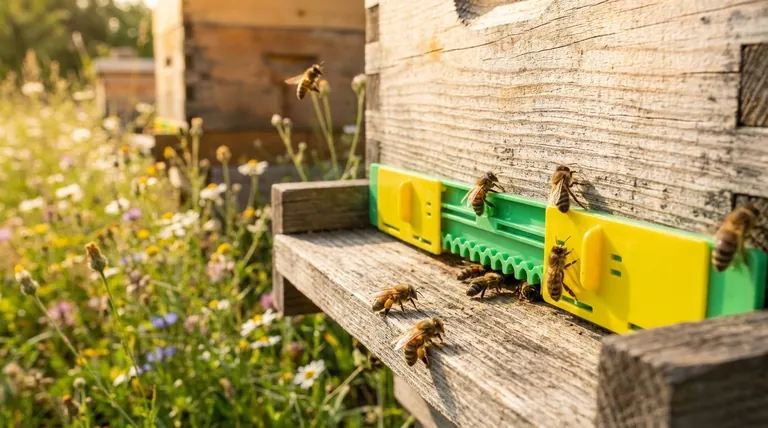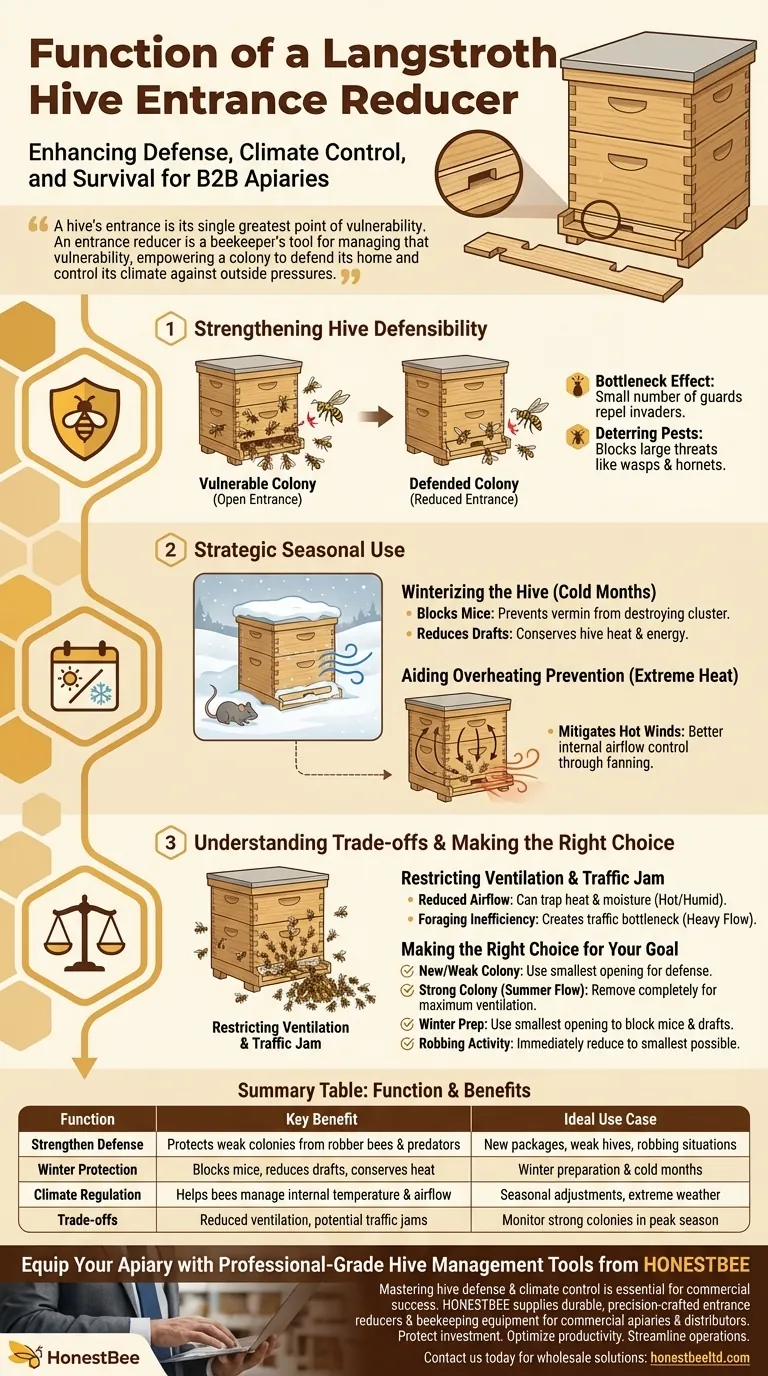At its core, an entrance reducer is a simple wooden strip used to shrink the main entrance of a Langstroth hive. Its primary function is to make the hive easier for the bees to defend, particularly when the colony is small or during the challenging winter months. It also plays a key role in protecting the hive from pests and regulating the internal environment.
A hive's entrance is its single greatest point of vulnerability. An entrance reducer is a beekeeper's tool for managing that vulnerability, empowering a colony to defend its home and control its climate against outside pressures.

The Primary Role: Strengthening Hive Defensibility
A colony's ability to protect itself is directly related to the size of the area it must guard. By constricting the entrance, you give your bees a significant defensive advantage.
Guarding a New or Weak Colony
When a colony is newly established or weak, it has a small population and fewer guard bees. A wide-open entrance is an open invitation for "robber bees" from stronger, nearby hives to invade and steal honey and pollen.
A reduced entrance creates a bottleneck. This allows a small number of guard bees to effectively repel a much larger force of invaders, protecting the colony's vital resources while it grows.
Deterring Pests and Predators
Beyond robber bees, a small opening is a physical barrier to larger threats. Wasps and hornets, which prey on bees, find it much more difficult to gain entry and overwhelm the guards at a constricted entrance.
Strategic Use in Seasonal Management
The need for a reduced entrance changes with the seasons and the strength of the colony. Its application is not permanent but a strategic management choice.
Winterizing the Hive
During winter, an entrance reducer is critical. The primary goal is to prevent mice and other vermin from entering the hive to seek warmth and food. A mouse can easily destroy a dormant winter cluster.
The smaller opening also helps the colony manage its internal climate by reducing cold drafts, allowing the bees to conserve energy and heat more efficiently.
Aiding Overheating Prevention
While it may seem counterintuitive, a reduced entrance can sometimes help with cooling. During extreme heat, a very large entrance can allow hot winds to blow directly into the hive. A smaller opening can mitigate this, allowing the bees to better control internal airflow through fanning.
Understanding the Trade-offs
Using an entrance reducer is not without its costs. The key is knowing when the benefits outweigh the drawbacks.
Restricting Ventilation
The most significant trade-off is reduced airflow. In hot and humid weather, a strong, populous colony needs a large entrance to properly ventilate the hive and prevent overheating. A restricted entrance can trap heat and moisture.
Creating a Traffic Jam
For a strong colony during a heavy nectar flow, a small entrance becomes a bottleneck. Foraging bees get backed up trying to get in and out, which reduces foraging efficiency and the amount of honey the hive can produce. This "bearding," or bees clustering on the outside of the hive, is a common sign of a restricted entrance combined with high heat.
Making the Right Choice for Your Goal
Deciding whether to use an entrance reducer, and which notch size to use, depends entirely on your colony's specific situation.
- If you are installing a new package or nuc: Use the smallest opening to give the growing colony the best possible defensive advantage.
- If your colony is strong during a summer nectar flow: Remove the reducer completely to maximize ventilation and forager traffic.
- If you are preparing the hive for winter: Use the smallest opening that allows for adequate ventilation while blocking mice.
- If you notice robbing activity from other bees: Immediately reduce the entrance to the smallest possible opening to help your bees defend themselves.
Ultimately, this simple piece of wood is a powerful tool for tilting the balance in your colony's favor.
Summary Table:
| Function | Key Benefit | Ideal Use Case |
|---|---|---|
| Strengthen Defense | Protects weak colonies from robber bees and predators | New packages, weak hives, robbing situations |
| Winter Protection | Blocks mice, reduces drafts, conserves hive heat | Winter preparation and cold months |
| Climate Regulation | Helps bees manage internal temperature and airflow | Seasonal adjustments, extreme weather |
| Trade-offs | Reduced ventilation, potential forager traffic jams | Monitor strong colonies in peak season |
Equip Your Apiary with Professional-Grade Hive Management Tools from HONESTBEE
Mastering hive defense and climate control is essential for commercial beekeeping success. At HONESTBEE, we supply durable, precision-crafted entrance reducers and a full range of beekeeping equipment designed for the demands of commercial apiaries and distributors.
We help you:
- Protect your investment with equipment that enhances colony survivability.
- Optimize hive productivity through strategic, seasonally-appropriate tools.
- Streamline your operations with reliable, wholesale-focused supply chains.
Ready to strengthen your hives and simplify your management? Contact our team today to discuss wholesale pricing and tailored solutions for your beekeeping needs.
Visual Guide

Related Products
- Multi-Functional Sliding Hive Entrance for Beekeeping
- Multi-Functional Rotary Hive Entrance Disc for Beekeeping
- Beehive Entrance Discs Plastic Bee Entrance Disc for Bee Hives
- Langstroth Bee Hives Bee Keeping Box for Beginners Beekeeping
- Multi-Function Hive Tool with Integrated Hammer for Beekeeping
People Also Ask
- Why is a smaller entrance size beneficial for a beehive? Boost Hive Defense & Productivity
- What is the purpose of placing an object in front of the hive entrance after a move? A Guide to Forced Reorientation
- How does the sliding design of the entrance reducer benefit beekeepers? Achieve Ultimate Hive Control
- What size is the entrance hole in a native bee hive? The 13mm Standard for a Thriving Colony
- How do bees manage debris with a small hive entrance? A Guide to Strategic Hive Management



















